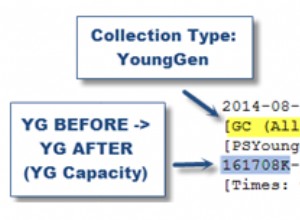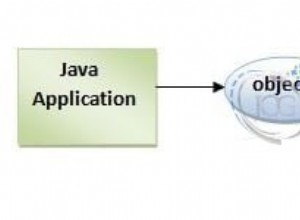Programme de motif de diamant en Java
Programme de motif de diamant en Java | Il existe différents programmes de modèles de diamants en Java. Ici, nous écrirons un modèle de demi-diamant, un modèle de diamant complet, un programme de modèle de diamant creux, différents programmes de modèle de diamant avec des nombres. Maintenant, commençons avec un programme de motif de diamant complet avec des étoiles.
*
***
*****
*******
*********
*******
*****
***
*Le programme pour le motif d'étoiles en diamant complet ci-dessus peut être écrit comme suit :
import java.util.Scanner;
public class DiamondPattern {
public static void main(String[] args) {
// take input
Scanner scan = new Scanner(System.in);
int n = 0;
System.out.print("Enter N value:: ");
n = scan.nextInt();
printStartDiamond(n);
}
private static void printStartDiamond(int n) {
if(n <= 0)
System.out.println("Enter Positive Number");
// for increasing portion
for(int i=1; i<=n; i++) {
// print space
for(int j = i; j<=n; j++) {
System.out.print(" ");
}
// print star
for(int k = 1; k <= 2*i-1; k++) {
System.out.print("*");
}
// new line
System.out.println();
}
// for decrement portion
for(int i=n-1; i >=1; i--) {
// print space
for(int j=n; j >= i; j--) {
System.out.print(" ");
}
// print star
for(int k=1; k <= 2*i-1; k++) {
System.out.print("*");
}
// new line
System.out.println();
}
}
}2. Ce modèle est juste l'opposé du modèle précédent. Écrivez un programme Java pour afficher le modèle d'espace et d'étoiles ci-dessous sur la console.
**********
**** ****
*** ***
** **
* *
** **
*** ***
**** ****
**********Le code Java pour le modèle ci-dessus peut être écrit comme,
import java.util.Scanner;
public class DiamondPattern {
public static void main(String[] args) {
// take input
Scanner scan = new Scanner(System.in);
int n = 0;
System.out.print("Enter N value:: ");
n = scan.nextInt();
printSpaceDiamond(n);
}
private static void printSpaceDiamond(int n) {
if(n <= 0)
System.out.println("Enter Positive Number");
// for first half portion (top to bottom)
for(int i=1; i <= n; i++) {
// print star
for(int j = i; j <= n; j++) {
System.out.print("*");
}
// print space
for(int k = 1; k < 2*i-1; k++) {
System.out.print(" ");
}
// print star
for(int l=i; l <= n; l++) {
System.out.print("*");
}
// new line
System.out.println();
}
// for second half portion
for(int i=n-1; i >= 1; i--) {
// print star
for(int j=n; j >= i; j--) {
System.out.print("*");
}
// print space
for(int k=1; k < 2*i-1; k++) {
System.out.print(" ");
}
// print star
for(int l=n; l >= i; l--) {
System.out.print("*");
}
// new line
System.out.println();
}
}
}
1
123
12345
1234567
123456789
1234567
12345
123
1Le programme Java pour le modèle ci-dessus est,
import java.util.Scanner;
public class DiamondPattern {
public static void main(String[] args) {
// take input
Scanner scan = new Scanner(System.in);
int n = 0;
System.out.print("Enter N value:: ");
n = scan.nextInt();
printNumberDiamond(n);
}
private static void printNumberDiamond(int n) {
if(n <= 0)
System.out.println("Enter Positive Number");
// declare temp variable
int a = 0;
// for first half portion (top to bottom)
for(int i=1; i <= n; i++) {
// in each iteration a will start from 1
a = 1;
// print space
for(int j = i; j <= n; j++) {
System.out.print(" ");
}
// print digit
for(int k = 1; k <= 2*i-1; k++) {
System.out.print(a++);
}
// new line
System.out.println();
}
// for second half portion
for(int i=n-1; i >= 1; i--) {
// in each iteration a will start from 1
a = 1;
// print space
for(int j=n; j >= i; j--) {
System.out.print(" ");
}
// print digit
for(int k=1; k <= 2*i-1; k++) {
System.out.print(a++);
}
// new line
System.out.println();
}
}
}
0
010
01210
0123210
012343210
01234543210
012343210
0123210
01210
010
0Le programme Java pour le modèle ci-dessus est,
import java.util.Scanner;
public class DiamondPattern {
public static void main(String[] args) {
// take input
Scanner scan = new Scanner(System.in);
int n = 0;
System.out.print("Enter N value:: ");
n = scan.nextInt();
printNumberDiamond(n);
}
private static void printNumberDiamond(int n) {
if(n <= 0)
System.out.println("Enter Positive Number");
// declare temp variable
int a = 0;
// for first half portion (top to bottom)
for(int i=1; i <= n+1; i++) {
// print space
for(int j = i; j <= n; j++) {
System.out.print(" ");
}
// print digit
for(int k = 1; k <= 2*i-1; k++) {
if(k < i)
System.out.print(a++);
else if(k == i)
System.out.print(a);
else
System.out.print(--a);
}
// new line
System.out.println();
}
// for second half portion
for(int i=n; i >= 1; i--) {
// print space
for(int j=n; j >= i; j--) {
System.out.print(" ");
}
// print digit
for(int k=1; k <= 2*i-1; k++) {
if(k < i)
System.out.print(a++);
else if(k == i)
System.out.print(a);
else
System.out.print(--a);
}
// new line
System.out.println();
}
}
}Programme de modèle de diamant creux en Java
*
* *
* *
* *
* *
* *
* *
* *
* *
* *
*Le code du modèle ci-dessus est,
import java.util.Scanner;
public class HollowDiamond {
public static void main(String[] args) {
// take input
Scanner scan = new Scanner(System.in);
int n = 0;
System.out.print("Enter N value:: ");
n = scan.nextInt();
printStarHollowDiamond(n);
}
private static void printStarHollowDiamond(int n) {
if(n <= 0)
System.out.println("Enter Positive Number");
// for first half portion (top to bottom)
for(int i=1; i <= n+1; i++) {
// print space
for(int j = i; j <= n; j++) {
System.out.print(" ");
}
// print digit or space
for(int k = 1; k <= 2*i-1; k++) {
if(k==1 || k==(2*i-1) )
System.out.print("*");
else
System.out.print(" ");
}
// new line
System.out.println();
}
// for second half portion
for(int i=n; i >= 1; i--) {
// print space
for(int j=n; j >= i; j--) {
System.out.print(" ");
}
// print digit or space
for(int k=1; k <= 2*i-1; k++) {
if(k==1 || k==(2*i-1) )
System.out.print("*");
else
System.out.print(" ");
}
// new line
System.out.println();
}
}
}
1
2 2
3 3
4 4
5 5
4 4
3 3
2 2
1Le code du modèle ci-dessus est,
import java.util.Scanner;
public class HollowDiamond {
public static void main(String[] args) {
// take input
Scanner scan = new Scanner(System.in);
int n = 0;
System.out.print("Enter N value:: ");
n = scan.nextInt();
printNumberHollowDiamond(n);
}
private static void printNumberHollowDiamond(int n) {
if(n <= 0)
System.out.println("Enter Positive Number");
// declare temp variable
int a = 1;
// for first half portion (top to bottom)
for(int i=1; i <= n; i++) {
// print space
for(int j = i; j <= n; j++) {
System.out.print(" ");
}
// print digit and space
for(int k = 1; k <= 2*i-1; k++) {
if(k==1 || k==(2*i-1) )
System.out.print(a);
else
System.out.print(" ");
}
// increase temp variable
a++;
// new line
System.out.println();
}
// update temp variable
a = n-1;
// for second half portion
for(int i=n-1; i >= 1; i--) {
// print space
for(int j=n; j >= i; j--) {
System.out.print(" ");
}
// print digit and space
for(int k=1; k <= 2*i-1; k++) {
if(k==1 || k==(2*i-1) )
System.out.print(a);
else
System.out.print(" ");
}
// decrease temp variable
a--;
// new line
System.out.println();
}
}
}Motif demi-losange
*
**
***
****
*****
****
***
**
*La variable étoile contient le nombre d'étoiles dans la nième ligne. Dans chaque ligne, la variable étoile est mise à jour. Quand i>n alors (2*n-i) sera négatif donc, la fonction abs() est utilisée pour trouver la valeur absolue de (2*n-i).
import java.util.Scanner;
public class HalfDiamond {
public static void main(String[] args) {
// take input
Scanner scan = new Scanner(System.in);
int n = 0;
System.out.print("Enter N value:: ");
n = scan.nextInt();
printStarHalfDiamond(n);
}
private static void printStarHalfDiamond(int n) {
if(n <= 0)
System.out.println("Enter Positive Number");
// declare temp variable
int star = 0;
for(int i=1; i < 2*n; i++) {
if(i < n) star = i;
else star = Math.abs(2*n - i);
// print star
for(int j = 1; j <= star; j++) {
System.out.print("*");
}
// new line
System.out.println();
}
}
}
*
**
***
****
*****
****
***
**
*Le programme Java pour le diamant creux d'étoiles en miroir ci-dessus,
import java.util.Scanner;
public class HalfDiamond {
public static void main(String[] args) {
// take input
Scanner scan = new Scanner(System.in);
int n = 0;
System.out.print("Enter N value:: ");
n = scan.nextInt();
printStarHalfDiamond(n);
}
private static void printStarHalfDiamond(int n) {
if(n <= 0)
System.out.println("Enter Positive Number");
// declare temp variable
int star = 0;
for(int i=1; i < 2*n; i++) {
// print star
for(int j = 1; j <= n; j++) {
if(j <= Math.abs(n-i))
System.out.print(" ");
else
System.out.print("*");
}
// new line
System.out.println();
}
}
}
1
2*2
3*3*3
4*4*4*4
5*5*5*5*5
4*4*4*4
3*3*3
2*2
1Le code Java pour le modèle ci-dessus peut être écrit comme,
import java.util.Scanner;
public class HalfDiamond {
public static void main(String[] args) {
// take input
Scanner scan = new Scanner(System.in);
int n = 0;
System.out.print("Enter N value:: ");
n = scan.nextInt();
printStarNumberHalfDiamond(n);
}
private static void printStarNumberHalfDiamond(int n) {
if(n <= 0)
System.out.println("Enter Positive Number");
// declare temp variable
int place = 0;
for(int i=1; i < 2*n; i++) {
if(i < n) place = i;
else place = Math.abs(2*n-i);
// print star or number
for(int j = 1; j < 2*place; j++) {
if(j % 2 == 0)
System.out.print("*"); // star
else
System.out.print(place); // number
}
// new line
System.out.println();
}
}
}
1
12
123
1234
12345
1234
123
12
1
Le code Java pour le modèle ci-dessus peut être écrit comme,
import java.util.Scanner;
public class HalfDiamond {
public static void main(String[] args) {
// take input
Scanner scan = new Scanner(System.in);
int n = 0;
System.out.print("Enter N value:: ");
n = scan.nextInt();
printNumberHalfDiamond(n);
}
private static void printNumberHalfDiamond(int n) {
if(n <= 0)
System.out.println("Enter Positive Number");
// declare temp variable
int place = 0, a = 0;
for(int i=1; i < 2*n; i++) {
// after every iteration
// initialize a with 1
a = 1;
if(i < n) place = i;
else place = Math.abs(2*n-i);
// print star or number
for(int j = 1; j <= place; j++) {
System.out.print(a++); // number
}
// new line
System.out.println();
}
}
}
1
123
12345
1234567
123456789
1234567
12345
123
1
Le code Java pour le modèle ci-dessus peut être écrit comme,
import java.util.Scanner;
public class HalfDiamond {
public static void main(String[] args) {
// take input
Scanner scan = new Scanner(System.in);
int n = 0;
System.out.print("Enter N value:: ");
n = scan.nextInt();
printNumberHalfDiamond(n);
}
private static void printNumberHalfDiamond(int n) {
if(n <= 0)
System.out.println("Enter Positive Number");
// declare temp variable
int place = 0, a = 0;
for(int i=1; i < 2*n; i++) {
// after every iteration
// initialize a with 1
a = 1;
if(i < n) place = i;
else place = Math.abs(2*n-i);
// print star or number
for(int j = 1; j <= 2*place-1; j++) {
System.out.print(a++); // number
}
// new line
System.out.println();
}
}
}


